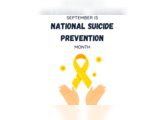September is National Suicide Prevention Month
Suicide is a significant public health concern. Deaths by suicide have been reduced over the years, yet still remain prevalent across the United States. According to the Centers for Disease Control, suicide dropped off the list of 10 leading causes of death in 2020 but still remains among the top 15. By understanding how to get help and recognizing the warning signs, action can be taken to help prevent suicide. Keep reading to understand the warning signs, factors that contribute to suicide, factors that reduce the risk of suicide, and helpful resources.
What causes suicide or suicidal attempts?
Typically no one situation, experience, or individual is to blame for suicidal thoughts or suicidal actions. Instead, a range of challenges tends to increase the risk of suicide. Read more from the CDC about circumstances that can increase suicide risk.
Warning Signs and Protective Factors
Along with circumstances that can increase suicide risk, there are also warning signs that you can recognize within yourself and others.
We all experience different emotions, and they can vary in terms of where we fall on the mental health spectrum. Recognize your own feelings and be aware of the frequency, duration, and any changes in patterns of behavior too. Patterns of unusual behavior may be cause for concern.
We can all do our part to help prevent suicide. Communities, individuals, and society can contribute to reducing the risk of suicide by supporting each other.
Different types of factors can help protect against the risk of suicide.
If you or someone else is experiencing thoughts of suicide or suicidal behaviors, here are tips and tools to help you navigate:
- Maintain healthy stress management and practice healthy coping skills, including boundaries.
- Practice healthy habits regularly to maintain your health and overall well-being.
- Seek out help and address how you're feeling. Help Guide provides this informative page that allows you to navigate suicidal feelings, what to expect when reaching out to a hotline and how to help someone that may be showing signs of suicide.
For more information, check out the tools listed below:
- Stress management guide - https://www.helpguide.org/articles/stress/stress-management.htm
- Facts about suicide - https://sprc.org/about-suicide
- How to talk to someone about suicide - https://www.bethe1to.com/bethe1to-steps-evidence/
- Resources to get help for yourself, those at risk, or if you've lost a loved one to suicide - https://afsp.org/get-help
- Suicide prevention resources and tools for mental health conditions - https://afsp.org/suicide-prevention-resources
- UMBC Counseling Center - https://health.umbc.edu/
- How to be there for someone - https://sprc.org/news/how-be-there
- Check out the National Alliance on Mental Illness (NAMI) - https://www.nami.org
- Contact #988 Suicide and Crisis Lifeline via text, phone call, or visit the website - https://988lifeline.org/
Posted: September 21, 2022, 2:41 PM
